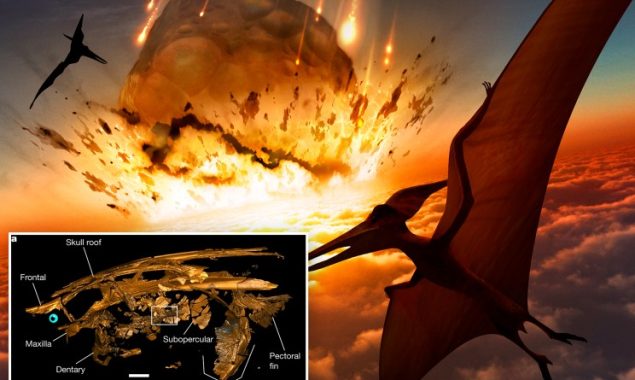Watch Video: A beautiful giant squirrel leaps and climbs the trees
It's entertaining to watch a squirrel jump from one limb to the...

A new study uncovers startling insights concerning dinosaur demise
So much for a spring rebirth.
The notorious meteor that wiped out the dinosaurs 66 million years ago was discovered to have impacted Earth during the northern hemisphere’s springtime — and this discovery could lead to further important discoveries about the planet’s unknowns.
These findings, published today in the journal Nature, shed light on why some species of mammals, crocodiles, turtles, and birds survived the Cretaceous extinction event, according to a team of European scientists from Vrije Universiteit, Uppsala University, and the European Synchrotron Radiation Facility.
Researchers discovered that when the Chicxulub meteorite landed in Mexico’s Yucatan peninsula, causing apocalyptic, global tsunamis and lasting effects that wiped out the dinosaurs and forever changed the planet, the planet’s seasonal climate may have inadvertently protected some of those prehistoric animals.
“Annual life cycles, including seasonal timing and duration of reproduction, feeding, hibernation and aestivation, vary strongly across latest Cretaceous biotic clades,” the paleontology team wrote.
“We postulate that the timing of the Chicxulub impact in boreal [northern] spring and austral autumn was a major influence on selective biotic survival.”
Colder weather months in the southern hemisphere, in contrast to our spring, may have also worked as a protective agent against the damage in ways that the planet’s warmer upper half couldn’t, the scientists discovered.
“Large-scale wildfires raging across the Southern Hemisphere may have been evaded by hibernating mammals that were already sheltered in burrows in anticipation of austral winter,” the authors wrote.
Researchers also revealed that the meteorite’s fallout, rather than its impact, is what killed the dinosaurs and altered life on Earth in the future.
“Although direct effects of the impact devastated a vast geographical area, the global mass extinction probably unfolded during its aftermath, which involved rapid climatic deterioration estimated to have lasted up to several thousands of years.”
These findings were made after the scientists examined preserved fish bones that had been subjected to the immediate effects of the meteorite’s impact.
The fish were buried alive by fragments of dirt that shifted dramatically when the blazing rock collided with the planet within the first hour of impact.
The samples were discovered in August of 2017 in the southwest region of North Dakota. According to their field report, the area contained “excellent proxies for reconstructing the environmental, climatological, and biological conditions” throughout the Mesozoic era.
After being dug, the specimens were studied at the ESRF facility in Grenoble, France, by a particle accelerator capable of producing the brightest X-rays on the planet.
According to SciTechDaily, the synchrotron X-ray tomography led to the discovery that fish bone composition — which changes seasonally on a micro level — coincided with springtime in what is now Northern America.
“We saw that both cell density and volumes were increasing but had not yet peaked at the year of death, implying that growth abruptly stopped spring,” Uppsala University researcher Dennis Voeten told the site.
Catch all the Trending News, Breaking News Event and Latest News Updates on The BOL News
Download The BOL News App to get the Daily News Update & Follow us on Google News.